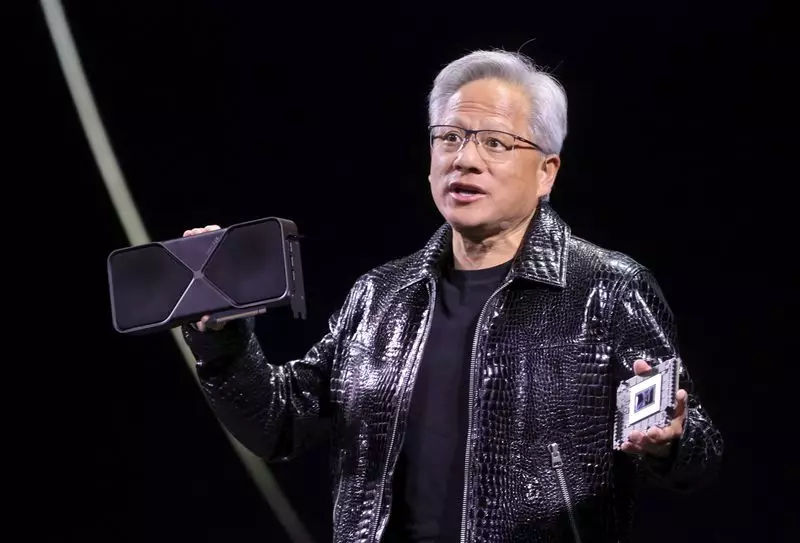Nvidia continues to dominate the tech narrative following its latest product announcements at CES 2025, an influential technology conference held annually in Las Vegas. The company has unveiled groundbreaking products, including cutting-edge artificial intelligence (AI) applications designed for training robotics and vehicles, advanced gaming chips, and its inaugural desktop computer. CEO Jensen Huang articulated a vision that intertwines Nvidia’s existing data center AI capabilities with consumer-focused solutions, marking an important expansion into mainstream markets.
During his keynote address, Huang showcased the Cosmos foundation models that generate synthetic, photo-realistic videos. These models are poised to be a game-changer, offering a feasible and economical alternative for training robots and self-driving cars. Traditional methods of acquiring training data—such as extensive field tests or extensive human intervention—are resource-intensive and time-consuming. By enabling users to input a text description that produces a corresponding video model adhering to physical laws, Cosmos promises to simplify and accelerate the training process. Analysts have noted the open licensing model for Cosmos, which is reminiscent of Meta Platforms’ Llama 3, undoubtedly presents an opportunity for increased collaboration and innovation in the robotics and AI spheres.
Skepticism in the Robotics Sector
While the potential for Cosmos is promising, not all industry experts are wholly convinced of its immediate impact. Vivek Arya, an analyst at Bank of America, highlighted the need for reliability, affordability, and scalability in these new tools. He warns that despite its allure, the robotics sector may remain a niche market if significant hurdles are not addressed. Echoing sentiments within the industry, Arya categorized the robotics initiative as potentially cool but noted its similarities to other advanced yet limited opportunities such as the metaverse or autonomous vehicles. Concerns rest on how effective Nvidia will be in transforming these innovations into real-world applications that provide tangible results and justify investments.
Nvidia’s foray into the gaming chip market with the introduction of its RTX 50 series represents a strategic move to enhance how video games are experienced. By leveraging ‘Blackwell’ AI technology—a backbone of its data center success—these chips aim to enrich gaming graphics to unprecedented heights. The rendering quality enhancement, particularly in ‘shaders’, is noteworthy. By incorporating imperfections that reflect real-world materials, such as subtle fingerprints and surface flaws, gamers will find themselves immersed in more lifelike environments. This could inspire game developers to create human character designs that resonate more authentically with players by reducing the uncanny valley effect that often deters realism in character creation.
The pricing strategy for these chips—ranging from $549 to $1999—positions Nvidia strategically within the gaming market. The initial shipments are set to roll out in late January, eagerly anticipating potential sales growth and expansion in gaming revenue. Ben Bajarin, a leading tech consultant, asserts that these innovations could serve as a short-term boost for Nvidia, reinforcing its reputation as a powerhouse in the gaming industry.
In a surprising twist, Nvidia also debuted its first desktop computer, dubbed Project DIGITS, aimed chiefly at software developers rather than the everyday consumer. Priced at $3,000 and built upon an Nvidia-oriented Linux operating system, the computer incorporates the sophisticated chip foundational to the company’s data center technology. This unique offering demonstrates Nvidia’s commitment to empowering individual software developers with tools that enable them to rapidly test AI systems—an appealing proposition for those in the tech industry looking to innovate.
The introduction of such specialized tools is reflective of a broader trend towards niche products in the tech landscape. By catering to developers, Nvidia can foster a thriving community that could result in innovative applications built upon its technology, thereby solidifying its role not just as a hardware provider, but as an incubator for future advancements.
Adding to the anticipated revenue streams, Nvidia’s partnership with Toyota to employ its Orin chips and automotive operating systems signifies a major entry into the automotive technology realm. This strategic collaboration aims at enhancing driver assistance systems in upcoming Toyota models, underlining the interoperability of Nvidia’s technology across diverse industries. Huang’s projections for Nvidia’s automotive hardware and software revenues reaching $5 billion by fiscal 2026 highlight a robust growth trajectory, even as the company seeks to boost revenue from multiple verticals.
In a landscape dominated by technological evolution, Nvidia’s comprehensive strategies to integrate artificial intelligence across various sectors herald a new era for both robots and gaming, encouraging exploration beyond traditional data-gathering methods. With the stakes high and competitive pressures mounting, it will be imperative for Nvidia not only to innovate but also to ensure that these innovations yield practical and reliable solutions for consumers and businesses alike. As the technology landscape unfolds, all eyes will be on Nvidia’s ability to turn its ambitious promises into reality.

